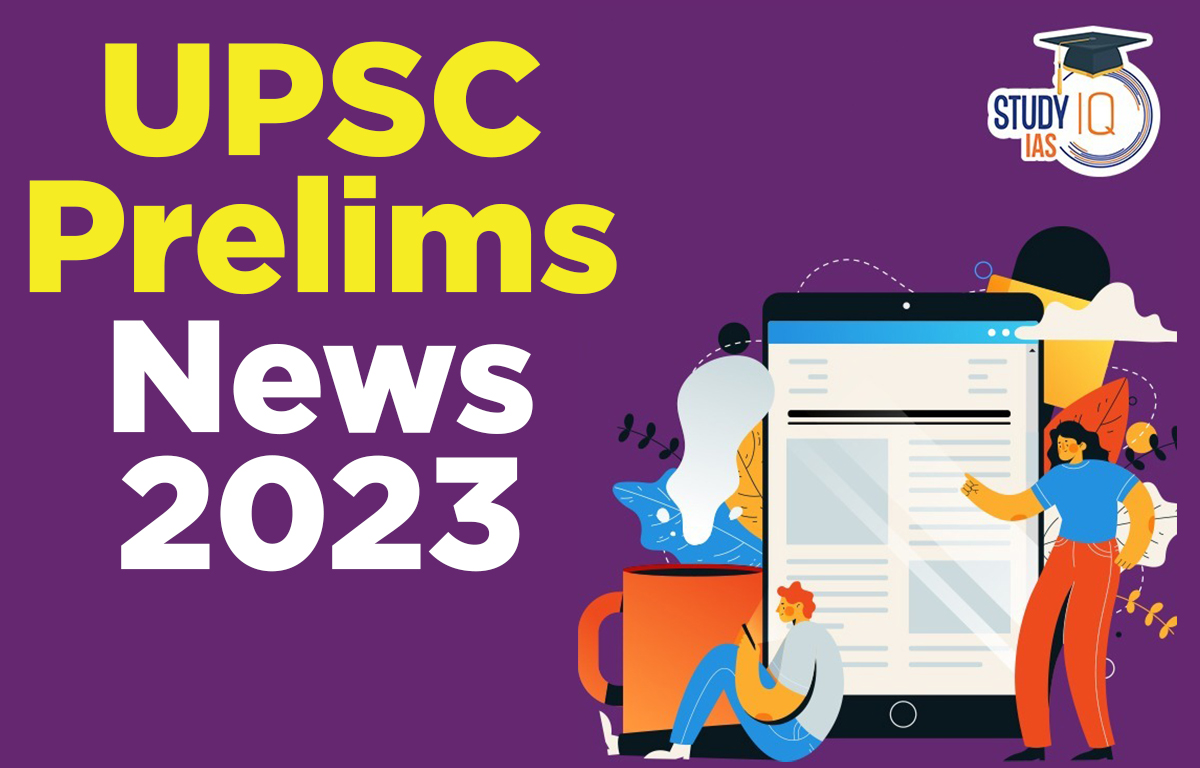UPSC Prelims News of 13 March 2023
Compassionate Appointment
Context: The Supreme Court has rejected some applications for ‘compassionate appointment’, filed by the dependents of deceased government employees in West Bengal.
The SC Ruling
- The court refused to grant validity due to absence of a policy governing compassionate appointments to posts under local authorities in West Bengal.
- It relied on the decisions made in ‘Mumtaz Yunus Mulani vs. State of Maharashtra’ and ‘State Bank of India vs. Surya Narain Tripathi’ cases while ruling.
- It further added that, even if such a policy existed, it would be of no use to consider the applications several years after they were filed.
- The court also referred ‘Sushma Gosain vs. Union of India’ and ‘Umesh Kumar Nagpal vs. State of Haryana’, saying that there shouldn’t be any delay in compassionate appointments, if the applicants are eligible.
About Compassionate Appointments
- Origin: The concept of compassionate appointment can be traced back to Article 39 of the Indian Constitution, which talks about the right to livelihood.
- Under the concept, employment can be provided on compassionate grounds to the dependent family members of a government servant who dies during service or retires on medical grounds, leaving the family without any source of sustenance.
- Criteria considered: Financial condition of the family, the presence of earning members, family size, children’s ages, and the essential needs of the family are looked while assessing request.
- Appointments on compassionate grounds can only be made for Group ‘C’ posts against the direct recruitment quota.
- Eligible applicants:
- Compassionate appointments apply to dependent family members of a government servant who:
- Dies during course of service (including death by suicide)
- Retired on medical grounds under Rule 2 of the CCS (Medical Examination) Rules 1957 or the corresponding provision in the Central Civil Service Regulations before 55 years of age (57 years for erstwhile Group ‘D’ Government servants);
- Retired on medical grounds under Rule 38 of the CCS (Pension) Rules, 1972 or the corresponding provision in the Central Civil Service Regulations before attaining the age of 55 years (57 years for erstwhile Group ‘D’ Government servants).
- It also applies to Armed Forces Employee who:
- Dies during service;
- Is killed in action;
- Is medically discharged and is unfit for civil employment
- The government employee must have been appointed on a “regular basis” and not on a daily wage, casual, apprentice, ad-hoc, contract, or reemployment basis.
- Compassionate appointments apply to dependent family members of a government servant who:
- Dependents of the employee: Dependents can only be first-degree relations such as spouse, son children (including adopted ones), and siblings in the case of an unmarried Government servant or member of the Armed Force.
- The applicant must be eligible and suitable for the post in all respects under the provisions of the relevant Recruitment Rules.
- Appointing authority: Joint Secretary in charge of administration in the Ministry or Department concerned.
- Head of the Department under the Supplementary Rule 2(10) in the case of attached and subordinate offices.
- They can also be made by the Secretary of a Ministry or Department in special cases.
UPSC Prelims News 11 March 2023
Fluorescent Microscopy
Context: Researchers have developed ‘glowscope’, a device that could democratize access to fluorescence microscopy.
About Fluorescence Microscopy
- A fluorescence microscope can observe an object by studying how it re-emits light that it has absorbed.
- In comparison, the optical microscope views an object by studying how it absorbs, reflects or scatters visible light.
- Working principle: The object is illuminated with light of a specific wavelength. Particles in the object absorb this particular light and re-emit it at a higher wavelength (i.e. different colour).
- These particles are known as fluorophores; the object is injected with fluorescent marker before being placed under the microscope.
- Applications: A fluorescent microscope can track fluoresce emitting fluorophores as they move inside the object, revealing the object’s internal shape and other characteristics.
- Ex: When a human tissue sample is injected with Hoechst stain (which has the ability to bind to the DNA) placed under a fluorescent microscope, it absorbs the light and re-emits it at a higher wavelength.
- The microscope can point out where this is happening: in the nuclei of cells, where DNA is located, allowing better labelling of the tissue.
- Drawbacks: The microscope costs at least a lakh rupee, but often goes beyond a crore.
Kuno National Park
Context: Two cheetahs from Namibia were released into the wild at the Kuno National Park (KNP) of Madhya Pradesh recently.
Facts about Kuno National Park
- Location: Kuno National Park is located in the Sheopur district of MP. It was set up in 1981 as a wildlife sanctuary. In 2018, it was given the status of a national park.
- Topography: Kuno River a tributary of the Chambal River flows through the National Park.
- It is located in the Vindhyan hills adjoining Rajasthan.
- Flora and Fauna: Kuno National Park is currently home to Indian wolves, jackals, leopards, langur monkeys, blue-bull, chinkara, and spotted deer.
- It is part of the Khathiar-Gir tropical dry deciduous forests. The vegetation is dominated by the “Kardhai”, “Khair” and “Salai” trees.
- Significance: Wildlife Institute of India and Wildlife Trust of India had shortlisted Kuno-Palpur as a potential habitat for Cheetahs and Asiatic lions.
- Other related information: People near the National Park mainly belong to the Saharia tribe.
SC/ST Act
Context: The Odisha High Court has recently made a judgment relating to an offence under the Scheduled Caste and Scheduled Tribe (Prevention of Atrocities) Act, 1989 (SC/ST Act).
About the Ruling
- The Odisha High court has said that, abusing a person by their caste name or suddenly uttering their caste in the course of events will, by itself, not amount to an offence under the SC/ST Act, unless an intention to insult or humiliate the victim owing to their caste or tribe identity is “prima facie established”.
About the SC/ST Act
- The Parliament, in recognition of the existing problems and inability of provisions to protect SC/ST, passed the Schedule Caste and Scheduled Tribes (Prevention of Atrocities) Act of 1989 and its Rules in 1995.
- The salient features of the Act are:
- Act is aimed at preventing the occurrence of crimes against Scheduled Castes and Scheduled Tribes.
- Special Courts have been established for the purpose of trying individuals charged with such atrocities.
- Funds are provided for their free rehabilitation, travel expenses, and maintenance expenses, with officers empowered to ensure that the act is appropriately implemented.
- Act sets out to make the Dalits an integral part of society and to protect their rights when crimes threaten to violate their social, economic, democratic, and political rights.
- Further, act works to prevent deprivation and assists marginalized communities in avoiding it.
- Legislation also provides a regime for monitoring the state’s retaliation against atrocities committed against Scheduled Castes and Scheduled Tribes, as the reports compiled by state should be submitted to the central government every year.
- Amendment: The act has been amended in 2015 and 2018, in order to strengthen the provisions to prevent atrocities against SC/STs.
Merapi Volcano Erupts
Context: Indonesia’s Mount Merapi has erupted, spewing out smoke and ash that blanketed villages near the crater.
About Mount Merapi
- There are more than 120 active volcanoes in Indonesia and Mount Merapi is the most active amongst all.
- Location: Mount Merapi volcano is located on the border of Central Java and Yogyakarta provinces.
- The mountain is situated just 30 km from Yogyakarta.
- Vulnerability: Merapi is one of the world’s most active volcanoes.
- It was already on the country’s second-highest alert level after the eruptions of 2020.
- The last major eruption of Mount Merapi was back in 2010, but since then there have been frequent minor volcanic eruptions with hot gas and lava flows.
- Attraction: Despite being one the most dangerous volcanoes in the world, Mount Merapi is a famous tourist destination.
- Mount Merapi, along with other volcanoes like Mount Semeru and Mount Bromo, continues to be a popular adventure destination in Indonesia.
Japanese Encephalitis Vaccination
Context: Recent study Japanese encephalitis vaccine SA-14-14-2 made in China, found very low levels of neutralizing antibodies IgG at different time points after vaccination.
About Japanese Encephalitis
- Japanese encephalitis is a viral brain infection.
- The microbe: Japanese encephalitis virus (JEV) is a flavivirus related to dengue, yellow fever and West Nile viruses, and is spread by mosquitoes.
- Vector: The disease is transmitted to humans through bites from infected mosquitoes of the Culex species.
- Spread: It’s most common in rural areas in Southeast Asia, the Pacific islands and the Far East, but is very rare in travellers.
- Carriers: The virus is found in pigs and birds and is passed to mosquitoes when they bite infected animals.
Japanese Encephalitis in India
- They are reported from several places in India, with the disease burden being highest in Gorakhpur region of eastern Uttar Pradesh.
- Immunization of children with the Chinese vaccine began in 2006 in 11 endemic regions and became a part of the Universal Immunization Programme in 2011 first with a single dose and subsequently (2013) with two doses.
- Despite vaccination, there have been several outbreaks in the endemic regions, particularly in Gorakhpur district.
About Jenvac Vaccine
- It is developed by Bharat Biotech in collaboration with NIV Pune using a virus strain collected in India.
- It has found superior protection at the end of two years even with a single dose.
- Jenvac has been approved as a single-dose vaccine; two doses of Jenvac are used as part of the Universal Immunisation Programme.
Plague
Context: The first major pandemic to affect India was the Third Plague Pandemic that began in Yunan, China, in 1855 and was considered to have been active until 1959.
About Plague:
- A pandemic is a disease outbreak that spreads across countries or continents. It affects more people and takes more lives than an epidemic.
- Plague is a serious and often deadly infectious disease caused by the bacteria Yersinia pestis.
- It is transported by flea-bites — they transfer the disease from infected rodents to human beings.
- There are three main types of plague: bubonic, septicemic, and pneumonic of which bubonic plague is the most common.
- It first presents flu-like symptoms — fever, chills, and a headache — followed by an inflamed, dry, extremely painful region developing around the bitten area.
- As the infection spreads in the body, it causes fatigue, swollen lymph nodes, excruciating pain and generally kills the infected person due to multiple organ failure within a week after infection.
- The antibiotic used will depend on the type of plague and the severity of the illness, but commonly used antibiotics include streptomycin, gentamicin, doxycycline, and ciprofloxacin.
- In addition to antibiotics, supportive care such as intravenous fluids, oxygen therapy, and management of complications may also be necessary.


 UPSC Prelims News 20 March 2023
UPSC Prelims News 20 March 2023
 UPSC Prelims News 17 March 2023
UPSC Prelims News 17 March 2023





















